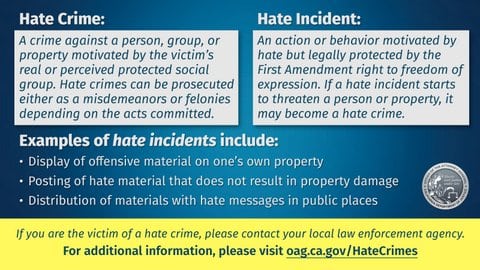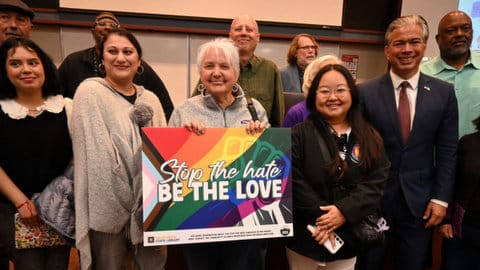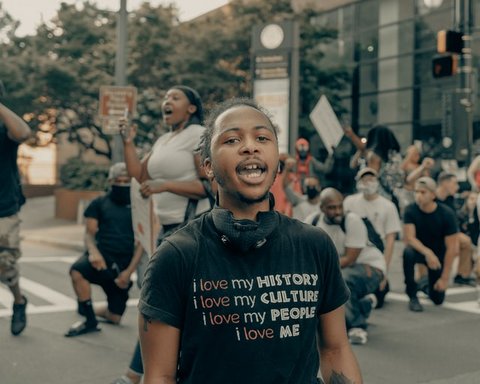
20 Dec What Is the Difference Between a Hate Crime and a Hate Incident?

Both hate crimes, which are illegal, and hate incidents, which are not, can be reported anonymously to CA vs Hate. (Office of the Attorney General / California Department of Justice)
By Michael J. Fitzgerald
California state law legally differentiates between hate crimes and hate incidents.
“A hate crime is a crime against a person, group, or property motivated by the victim’s real or perceived protected social group,” according to the office of state Attorney General Rob Bonta.
But a hate incident “is an action or behavior motivated by hate but which, for one or more reasons, is not a crime.” In other words, the act is hateful but not illegal. A hate incident is not a hate crime simply because it is not a crime at all.
“While these acts are certainly hurtful, they do not rise to the level of criminal violations and thus may not be prosecuted,” the AG’s office says.
The attorney general’s office says examples of hate incidents not considered actual crimes include:
- Name-calling
- Insults
- Displaying hate material on your own property.
- Posting hate material that does not result in property damage.
- Distribution of materials with hate messages in public places.
A hate crime is a criminal act in which it is proven that the victim was targeted because of disability, gender, nationality, race or ethnicity, religion, and sexual orientation. That includes the victim’s actual identity, the suspect’s apparent perception of their identity, or the victim’s association with any of these protected identities.
“Hate crimes are serious crimes that may result in imprisonment or jail time,” the office says.
Earlier this year, Simon O’Connell of the Contra Costa County District Attorney’s office used the example of a person marching in a parade in support of the LGBTQ+ community being verbally and/or physically assaulted. Even though the victim might not be gay, hate crime laws protect them too. O’Connell is the chair of the hate crimes committee in the DA’s office.
>>>Read: Panel Outlines Strategies for Battling Hate, Hate Crimes
He also noted that in some such cases, defendants plead guilty to crimes to avoid any enhanced penalties they might face if the offense is considered by the courts to be a hate crime.
However, a crime having an element of hate, such as the suspect calling the victim a slur, does not automatically it a hate crime. What matters is the suspect’s motivation — and what prosecutors can prove.
“Bias motivation can be hard to prove, and prosecutors can be reluctant to take cases that that they may not win in court,” writes Indiana University law professor Jeanine Bell for The Conversation.
The state attorney general’s office offers assistance to law enforcement to help officials decide whether a situation is a hate incident or a hate crime, including lengthy published list of examples that provide circumstantial evidence helping to indicate whether the defendant’s motive might have been hate-based.
Examples include:
- The defendant and the victim were of a different race, religion, disability, sexual orientation, ethnicity, gender, and/or gender identity, or the defendant perceived them to be.
- The defendant made bias-related oral comments, written statements, gestures or wore clothing or possessed objects reflecting bias.
- The defendant has a prior hate incident or hate crime conviction or belongs to a hate group.
- The presence of bias-related drawings, markings, symbols, or graffiti at the crime scene.
- The victim belongs to a minority group in the neighborhood where the victim lives and the incident took place.
- Crimes of violence in which the force used is particularly gruesome.
- Prior bias incident or crimes in the same locality and involving victims of the same race, religion, disability, sexual orientation, ethnicity, gender, or gender identity.
- A substantial portion of the community where the crime occurred perceived that the incident was motivated by bias.
- The victim was engaged in activities related to their race, religion, disability, sexual orientation, ethnicity, gender, or gender identity.
- The incident coincided with a holiday or a date of significance to a particular race, religion, disability, sexual orientation, ethnicity, gender, or gender identity.
Any victim of or witness to a hate incident or crime in California can report it and receive support any time at CAvsHate.org. You can also call 833-8-NO-HATE; (833) 866-4283 Monday – Friday from 9:00 am – 6:00 pm. If outside of those hours, you can leave a voicemail, or you can call 211 to report hate and seek support. You can currently submit reports online in 15 languages and, when calling the hotline, you can get access to support in over 200 languages. If you want to report a hate crime to law enforcement immediately or you are in present danger, please call 911.
This resource is supported in whole or in part by funding provided by the State of California, administered by the California State Library in partnership with the California Department of Social Services and the California Commission on Asian and Pacific Islander American Affairs as part of the Stop the Hate program. To report a hate incident or hate crime and get support, go to CA vs Hate.






No Comments